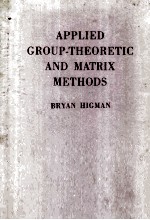

Applied Group-Theoretic and Matrix MethodsPDF电子书下载
- 电子书积分:15 积分如何计算积分?
- 作 者:Bryan Higman
- 出 版 社:At The Clarendon Press
- 出版年份:1955
- ISBN:
- 页数:454 页
PART Ⅰ FINITE GROUPS 1
Ⅰ.ABSTRACT FINITE GROUPS 1
1.2.The cyclic group of order 2
1.3.The dihedral groups 3
1.4.S-groups 5
1.5.Permutation groups 5
1.6.Basic definitions and theorems 7
Ⅱ.MATRIX ALGEBRA 10
2.2.Linear operators 10
2.3.Combinations of operators 12
2.4.Matrix algebra and group theory 13
2.5.Non-square matrices 14
2.6.The theory of vector spaces 14
2.7.Eigenvectors and eigenvalues 16
2.8.Functions of a diagonal operator 18
Ⅲ.COMPLEX AND HYPERCOMPLEX NUMBERS 20
3.2.Scalar products and vector duals 20
3.3.Related matrices:(i)the adjoint and reciprocal 22
3.4.Related matrices:(ii)the transpose and associate 23
3.5.Related matrices:(iii)orthogonal and unitary matrices 23
3.6.Eigenvalues of special matrices 24
3.7.Reciprocal vectors 25
3.8.Dyads and dyadics 26
3.9.Linear algebras 30
3.10.Nomenclature 32
Ⅳ.CONJUGATION AND EQUIVALENCE 33
4.2.Conjugation 34
4.3.Factor groups 34
4.4.The implications of equivalence 36
4.5.The algebra of classes 37
4.6.Oblique axis theory 37
4.7.Reduction of a matrix to diagonal form 41
4.8.Functions of an arbitrary operator 42
Ⅴ.REPRESENTATIONS--THE HEART OF THE MATTER 45
5.2.Reducibility 45
5.3.The fundamental theorems 48
5.4.Some simple corollaries 50
5.5.Group characters 51
5.6.Induced and Kronecker product representations 54
Ⅵ.REVIEW OP GROUPS TO ORDER 24 58
6.2.Cyclic groups 58
6.3.S-groups 58
6.4.Groups up to order 6 60
6.5.Groups of orders 7 and 8 62
6.6.Direct product and generalized dihedral groups 64
6.7.Groups of orders 9 to 24;symmetric groups 66
Ⅶ.MISCELLANEOUS ADDENDA AND NUMERICAL METHODS 72
7.2.Matrices not reducible to diagonal form 72
7.3.Numerical evaluation of determinants 74
7.4.The reciprocal of a matrix 76
7.5.Computation of eigenvalues and eigenvectors 78
7.6.The orthogonality relations 83
7.7.Operator space 86
7.8.Some miscellaneous proofs 89
PART Ⅱ APPLICATIONS OF FINITE GROUPS 90
Ⅷ.THE EXTERNAL FORMS OF CRYSTALS 90
8.2.Forms without multiple axes 93
8.3.Forms with one multiple axis 95
8.4.Forms with more than one multiple axis 96
8.5.Graphical representation of symmetry types 99
Ⅸ.THE INTERNAL STRUCTURE OF CRYSTALS 102
9.2.The lattice hypothesis 104
9.3.The three-dimensional point lattices:(i)from lattice to symmetry 108
9.4.The complete lattice group 110
9.5.The three-dimensional point lattices:(ii)from symmetry to lattice 118
9.6.The conventional axes and matrices 122
9.7.The space groups 125
9.8.The reciprocal lattice 133
Ⅹ.THE VIBRATIONS OF MOLECULES 136
10.2.Procedure for transformation of coordinates 137
10.3.The normal modes of symmetrical molecules 139
10.4.The structure of the ozone molecule(i) 140
10.5.Numerical determination of natural frequencies 147
Ⅺ.FACTOR ANALYSIS 149
11.2.The basic problem of factor analysis 149
11.3.A simple solution 151
11.4.Correlation and rank 152
11.5.Correlation and error 154
11.6.Transformations of the f-space 157
11.7.Rotation of axes and oblique factors 161
11.8.Application to the problem of aromatic activity 163
11.9.Spearman's approach 170
PAST Ⅲ CONTINUOUS GROUPS AND APPLICATIONS 174
Ⅻ.CONTINUOUS GROUPS:INTRODUCTION 174
12.2.Representations and characters in continuous groups 174
12.3.The groups u2 and r3 177
12.4.Representations of u2 and r3 182
12.5.The numerical groups 185
12.6.Infinitesimal operators and the group manifold 187
12.7.Differential operators and Hilbert space 189
12.8.Eigenvector theory in Hilbert space 196
12.9.Functions of two or more variables 202
ⅩⅢ.THE SYMMETRIC AND FULL LINEAR GROUPS 205
13.2.The simple symmetric functions 205
13.3.Relations between the symmetric functions 207
13.4.The Kronecker mth power 209
13.5.The simple characters of fn 212
13.6.The characters of the symmetric groups 215
13.7.Schur functions 219
13.8.Further development of Schur functions 222
13.9.Subgroups of the symmetric and full linear groups 226
13.10.The spinor group 231
ⅩⅣ.TENSORS 237
14.2.The metric tensor 237
14.3.General notions 239
14.4.The volume element and the Laplace operator 244
14.5.Tensor properties of matter:(i)symmetrical tensors 249
14.6.Tensor properties of matter:(ii)in crystals 255
14.7.The identification of tensor types 259
ⅩⅤ.RELATIVITY THEORY 266
15.2.The Galilean transformation 267
15.3.The Lorentz group 268
15.4.The representations of the Lorentz group 270
15.5.The four-dimensional principle 273
15.6.Curvature of space 277
15.7.The basic principles of general relativity 283
15.8.Relativistic and quantum-relativistic units 284
ⅩⅥ.QUANTUM THEORY 288
16.2.The basic postulates 289
16.3.Vector observables 292
16.4.The commutation rules and wave functions 296
16.5.The Schrodinger equations 301
16.6.The free particle and the simple harmonic oscillator 306
16.7.Central force fields and spherical harmonics 308
16.8.Perturbation theory 315
16.9.Symmetry considerations 320
16.10.n-Electron systems 335
ⅩⅦ.MOLECULAR STRUCTURE AND SPECTRA 344
17.2.Diatomic molecules 345
17.3.Methods of molecular analysis 352
17.4.Tetrahedral molecules 358
17.5.Covalency maxima and stereochemistry 366
17.6.Unsaturated compounds 374
17.7.Spectra and selection rules 385
17.8.The structure of ozone(ii) 393
17.9.Related problems in crystals 399
ⅩⅧ.EDDINGTON'S QUANTUM RELATIVITY 402
18.2.The nature of measurement 403
18.3.Measures and measurables 404
18.4.The E-frame and sedenion algebra 406
18.5.Rotations and reality conditions 409
18.6.Anchoring the E-frame 411
18.7.The primary analysis 417
18.8.k-Factor theory 419
18.9.Strain vectors and quantum theory 425
18.10.The double frame and wave tensors 430
18.11.The cosmic number 440
18.12.Conclusions 441
BIBLIOGRAPHY 444
INDEX 449
- 《顾客关系轻松做 藉由有效的顾客关系管理获利》BRYAN BERGERON 布莱恩·柏格伦著;箫慕一译 2002
- 《生个孩子吧:一个经济学家的真诚建议》(美)布莱恩·卡普兰(Bryan Caplan)著;陈佳伶译 2012
- 《让心灵重新充满爱有勇气改变》MOLLIE COX BRYAN著;陈世玲译 1999
- 《直线与圆》(英)白里格(W.Briggs),(英)白里安(G.H.Bryan)著;刘铁楼译 1948
- 《地位》布赖恩·特纳(Bryan S. Turner)著;慧民,王星译 1991
- 《应用概率》(美)沃兹沃思(G.P.Wadsworth),(美)布赖恩(J.G.Bryan)著;林少宫等译 1982
- 《Blackwell社会理论指南 第2版》(英)布赖恩·特纳(Bryan S.Turner)编;李康译 2003
- 《毛泽东的政治哲学 插图本》(美)约翰·布莱恩·斯塔尔(John Bryan Starr)著;曹志为,王晴波译 2006
- 《探识生物学 第9卷 进化》(英)布赖恩(K. Bryan)等著;马金生等译 2005
- 《探识生物学 第8卷 生殖》(英)布赖恩(K. Bryan)等著;李田,孙平译 2005
- 《你也可以创造生命的奇迹 来自全球的自我疗愈实证与方法 miraculous moments and extraordinary stories from people all over the w》露易丝·贺(Louise L. Hay)著 2012
- 《“中国印”的世界 骆芃芃篆刻书法艺术展作品集 the collection of exhibition of seal engraving and calligraphic works》骆芃芃著 2012
- 《THE CASE-STUDY METHOD IN PSYCHOLOGY AND RELATED DISCIPLINES》 1986
- 《冷战后美日同盟转型研究=STUDY ON TRANSFORMATION OF THE US-JAPAN ALLIANCE AFTER THE COLD WAR》衣昭杰著 2020
- 《现代艺术的源代码=THE SHORT STORY OF MODERN ART》(英)苏西·霍奇著 2020
- 《信念共同体:法与经济学的新方法=THE REPUBLIC A NEW APPROACH TO LAW AHD ECONOMICS》(印)考希克·巴苏(KaushilBasu)著 2020
- 《唐帝国的香气=A BRIEF HISTORY OF THE TANG DYNASTY》殷靖著 2020
- 《细节中的新中国史=THE HISTORY OF THE PEOPLES REPUBLIC OF CHINA IN DETAILS》张神根 2020
- 《表达自由的法律界限:美国最高法院的探索=THE LEGAL BOUNDARIES OF FREE SPEECH:THE UNITED STATES SUPREME COURTS E》郑海平著 2019
- 《IAF群体引导手册 来自引导界顶级组织的最佳实践=THE IAF HANDBOOK OF GROUP FACILITATION BEST PRACTICES FROM THE L》(美)桑迪·舒曼编 2020
